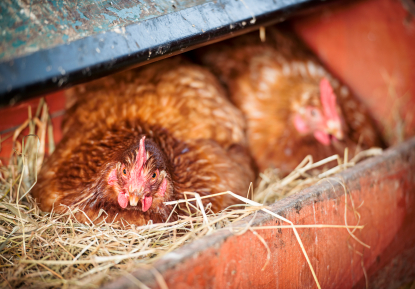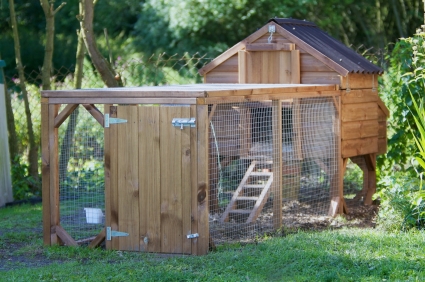With keeping chickens comes the responsibility of providing them adequate housing. This article covers important considerations for buying or building the perfect chicken house for your poultry.
Because many plans for building poultry housing are already freely available on the internet, this article will concern itself more with what's required to keep poultry safe, happy and productive in terms of space and amenity requirements. Armed with this knowledge, you should be able to build, modify or purchase a chicken coop that’s suitable to your poultry’s needs and will keep them safe and contented.
What makes poultry happy/unhappy?
Research now provides a very good idea of what makes poultry happy and productive. Interestingly, the findings closely reflect the behaviours of the wild red jungle fowl of Southern Asia, from which all domesticated poultry are descended. In the wild, red jungle fowl form small, complex social groups. Much of their waking time is spent foraging over large distances, taking dust baths and preening themselves. Prior to laying they seek secluded spots for nest building and at night, they fly up into trees to avoid predators and roost.
|
While poultry are often labelled 'bird brained', research indicates they're remarkably intelligent and have capacity to feel emotion. Poultry readily recognise each other and their place within the flock. They make friends with some and will avoid those they dislike. They learn from each other, exhibit self-control and anticipate the consequences of their actions. They can feel frustration and even anxiety for the future if their natural behaviours are impeded.
If poultry are unable to express their natural behaviours and desires to socialise, leg stretch, wing flap, tail wag, walk, dust bath, preen, forage around, make a nest, or roost due to fear or lack of space, they quickly display deprivation symptoms similar to those housed in battery cages.
Ideal flock size
Flock size is another important consideration with regard to keeping chickens happy. Poultry have a preference for small groupings of 5 to 10 individuals where they can easily recognise and interact with each other. They will happily be part of larger groupings, provided there's sufficient room for all.
Space requirements – industry standard
The current industry standard in Australia for 'battery caged hens' allows a minimum area of no more than that of an A4 piece of paper. By any measure this is abhorrent and unacceptable.
In order to exhibit full leg and wing flexing and flapping behaviours, hens show a preference for a minimum (indoor) floor area of about 13,700cm2 (117cm x117cm, i.e. a little over a square metre) each with a minimum height requirement of 60cm. Keep this as an absolute minimum when buying or building a chicken house.
Nesting requirements
Chickens prefer discrete nesting areas (30cm x 30cm recommended) with loose straw-like materials for bedding. Most poultry lay in the morning and will spend around 45 minutes laying. Insufficient nesting sites can cause stress so it is recommended the number of nests represent around 40% of the flock numbers.

Dust baths
Poultry love a dust bath, and will take one every other day, spending around half an hour at a time.
Dust baths followed by preening help remove parasites and oils and keep feathers in good condition. Given dry conditions, chickens will soon create their own dust baths. In wet conditions, or where soft soil is not available, such as inside a concrete floored coop, 'dust baths' can be made using a large old tyre or wooden boxing. These can be covered when wet for outside use. They need to be at least 20cm deep and four to five chickens will happily share an area of one square metere. Dust material can be made out of light garden soil, or fine sand. Mixtures of sand, dichotomous earth and wood ashes are popular 'dust recipes', since the dichotomous earth and wood ashes are both known to help reduce parasite loadings on a chicken's skin and feathers.
Perches
For poultry to feel safe from predators, they need to be sufficiently high off the ground. A minimum perch height of 50cm is recommended, requiring no more than a short wing-assisted hop by the hen. A perch length of 15cm or more per bird is recommended.
Wooden poles of 55-65mm diameter are suitable, but secure them so they can't turn. Where using 'square' cut lengths, plane the edges so the hen's claws can comfortably curl around them when resting.
Multiple rows at increasing heights facilitate poultry's pecking order behaviours. Allow a minimum spacing of 45cm between rows.
Foraging and free range requirements
Poultry will happily walk up to 2.5km daily and peck up to 15,000 times as they forage for food, yet are still motivated to forage even when food is otherwise provided.
For 'free range' conditions, a minimum of 4 square metres (2m x 2m) of vegetated area per hen is recommended. The presence of trees or artificial cover is recommended in foraging areas as this makes them feel safe and encourages them to venture out. Keeping chickens on a large piece of land does give them more exposure to predators however.
Protection from predators
The Australian landscape can present several predator challenges to domestic fowl. Snakes, wild dogs, foxes, rats, the native quoll and even raptor birds can all cause heartbreaking carnage.
Chicken housing can be made predator proof by ensuring the flooring, walls and roof are fully enclosed, with any openings protected with 10mm x 10mm mesh 'budgie' wire netting. All gaps and openings must be targeted since quoll, snakes and even foxes can access even the smallest of openings.
To avoid fox attacks, netting is required for the roof of yards as foxes are adept at scaling fences, even when electrified. A curved overhang will also help. Netting should be buried 450mm into the ground (150 mm for quoll), since foxes excel at digging. Alternatively, an outward facing apron of netting buried no more than 5-10cm projecting 500mm from the base will suffice.
Outdoor pens can be lined with corrugated iron or shade cloth from ground level to around 600mm height to stop foxes or wild dog from seeing poultry.
Where to from here?
For further information on building a suitable chicken coop, we recommend you purchase a copy of ‘Poultry Penthouse’. This book provides specifications for building a semi-portable chicken house for about 12-15 poultry. Our next article will look at feeding and water options suitable for poultry in small farm situations.
 |
The author, Roger has spent 20 plus years working in agriculture and horticulture since graduating from Massey University with an Agricultural Science degree. He has helped many farmers improve their farm productivity and profitability as well as often increasing the enjoyment they got out of farming. |



